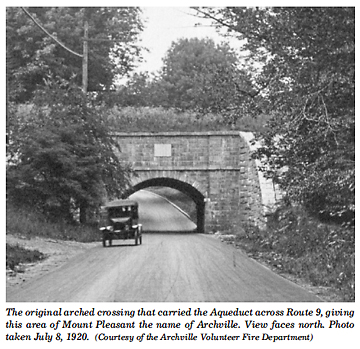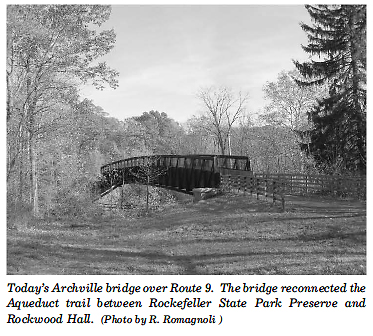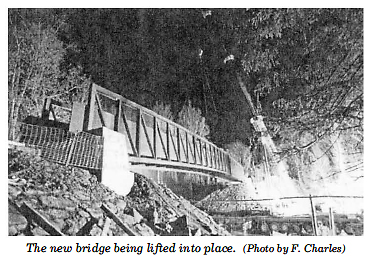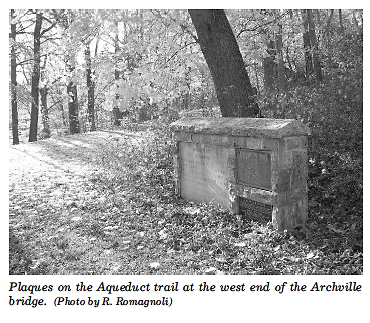
The first issue of the Friends’ newsletter, dated April 1998, opened with a few short paragraphs titled “Putting the Arch Back in Archville.” It reported that a new bridge had been set in place the previous November high overRoute 9 north of IBM’s Mount Pleasant campus, now occupied by New York Life. The bridge provides a safe and convenient crossing for Aqueduct walkers over a dangerous section of roadway, and connects the main area of Rockefeller State Park Preserve with its Rockwood Hall section. The article noted “The new bridge opens up a section of the trail that hasn’t been used for more than 70 years, since the original massive aqueduct arch for which Archville was named was taken down as a traffic hazard.”
At the time, John Middlebrooks was State Parks’ manager of the Rockefeller Preserve, while colleague and friend Brian Goodman was the agency’s manager of the Aqueduct trailway. Both have since retired. My question to Brian asking why the bridge was designed with such high sides on its walkway elicited some tantalizing comments and led him to connect me with John, who contributed the following account. – Ed.

“The bridge design was a collaboration between me and engineer Mike Berry of Sasaki Associates in Boston. DOT [New York State Department of Transportation] wanted the traditional highway overpass bridge structure usually built in such circumstances . . . our intention was to restore the historic carriage road link between the two Rockefeller estates: John D. Senior’s Kykuit and his brother William’s estate at Rockwood Hall. With that in mind we needed to insure the safety and two-way access over this narrow portion of the Aqueduct surface - the top of the trail on the east side as it approaches the bridge is exactly the width of the water tunnel and some 29 feet above Route 9.
“The trail here had been used as a bridle path before the arched crossing was removed and is popular with equestrians today. If you look closely at the interior design of the bridge structure you will see it resembles a traditional horse stall - wood plank sides with a wire fence top. DOT wanted the wire mesh to go completely around the top of the bridge. I said we could not put a ‘top’ over the bridge - it would spook the horses. Also, note that the surface of the bridge is the same as on the Preserve’s carriage roads, a material we developed which has since been adopted by DOT as an alternative to asphalt for handicapped accessibility trails. . . . [This and other details were] adopted by DOT, which now uses this bridge as a model for other equestrian access bridges.

“Visibility and safety were foremost concerns in looking at the approaches to the bridge, especially on the long east side. The rail fence we used along the approach was also done to calm the horses, since they would recognize it as a standard paddock fence. You do not get a full appreciation of this bridge design or the approaches (especially for the safety of the rider or carriage driver) until you have crossed it on horseback or carriage. The high, solid sides had another advantage in that they lessened the noise from the highway below, minimizing the likelihood that a horse would ‘spook’ halfway across and throw a rider - which could have been fatal if it happened on the elevated section of the trail. “I also prevailed upon DOT to move the plaques recording the various transitions of this bridge over its history to the top of the trail so that anyone could appreciate the history of the structure. This was no little item since it ultimately cost over $50,000 to remove them from along Route 9, where they were being destroyed by close proximity to vehicle exhaust, and to relocate them, along with a new plaque to explain the new bridge. As to the whole cost of the bridge project, just over $1 million, none of it came from state funds. The design and engineering were paid for by the Rockefeller family and the cost of the bridge came from federal highway funds . . . Finally, we used Core Ten steel (self-rusting) because it was the only acceptable alternative to the granite I had originally wanted but which would have cost more than the funding available . . . . In addition, it matched the two bridges over Route 117 which the Rockefellers had built. 
“The DOT engineer-in-charge of the project was a Russian expatriate by the name of Boris Vays. He was one of the best engineers I have ever had the pleasure to work with . . . He managed not only to get the bridge built ahead of schedule but also below the DOT estimate for the project. . . . The bridge structure was erected in one day with one of the largest cranes on the East Coast, and the vehicle the crane was mounted on was a former Russian missile launcher—you should have seen the look on Boris’s face when it showed up! He got so excited that he pulled me down off the east abutment and ran to the driver’s door on the truck cab, pulled it open (much to the surprise and shock of the crane operator), and proudly showed me the vehicle registration plate—which was in Russian, which Boris read to me. The bridge was prebuilt in Georgia, shipped up to the site in two pieces, assembled on Route 9, and lifted whole and set into place. The alignment was off by only one-eighth inch, which was corrected then and there . . . The installation process was extremely delicate; major electric service lines on the west side of the bridge were just 10 feet above the final bridge elevation, the minimum allowed. 
“One final historical note on this bridge. When the original Archville bridge was removed in 1924 the water tunnel was severed and replaced with an inverted siphon so that the use of the Aqueduct could continue. . . . The Aqueduct tunnel was terminated when Route 117 was built. It was no longer needed for a water supply so the thinking at the time was that it wasn’t necessary to go through the expense of rerouting it, probably as another inverted siphon. . . . It may be of interest to note that the pipe that passes through the arched opening at the base of the high Aqueduct embankment through which the Pocantico River flows supplied water to the former General Motors plant in Sleepy Hollow.
”So, there you have it—the story of the new bridge over Route 9 that restored the continuity of the Aqueduct trail in that area.”

